Rugs are woven on looms. Warp yarns that will run the length of the rug are stretched between two beams. Wefts yarns are interlaced across the warp yarns. Weft yarns may be heavy and stiff which forces the warp yarns to curve as the weft yarns are forced between alternate warp yarns. In other cases, weft yarns are thin and pliable and follow a sinuous path around heavier warp yarns. Many rugs use both types of weft yarns.
Lengths of the face yarn are tied around two adjacent warp yarns. In some cases, face yarns may be tied around 4 warp yarns to reduce the number of knots required and thus reduce labor.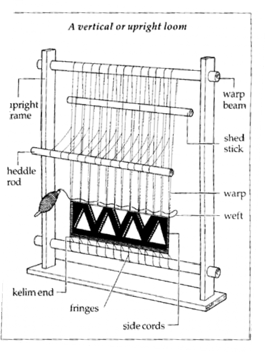
A row of knots is tied across the width of the rug. Then one or more weft yarns are inserted. The wefts and the knots are pounded down close together to hold the face yarns in place. When only one weft yarn is used between each row of knots, it is called a single weft. Looking at the back of a single-weft rug, short sections of the warp yarn will be exposed and you may notice them form a diagonal repeat when viewed from the back.
Two types of knots are commonly used, but these are not the only types of knots used. The Turkish knot is also known as a symmetrical knot. The Persian knot is also known as a Senneh knot or an asymmetrical knot. When the ends of the Persian knot are pulled tightly, alternating warp yarns will be lifted. When viewed from the back side, every other warp yarn is hidden. This is called a depressed warp. As a result, the knots can be closer together, the rug will be thicker and more durable if all the warps were laying flat in the same plane. The back of a woven rugs will look like the design on the front.
Depressed warps are common with asymmetrical knots but can also be found in rugs woven using symmetrical knots.
The symmetrical Turkish tends to be associated with rugs woven in Turkey, the Caucasus region, and the western part of Iran while the Persian knot is associated with central and eastern Iran (Persia), Afghanistan, Pakistan, and areas east of the Caspian Sea. However, people migrate and carry their methods with them. So, the type of knot used is at best one element that may help identify the origin of a rug.
When the rug is completed, the warp yarns will be cut from the beam and gathered together to become the fringe.
A flat strip with no face yarns may be left at the ends of a rug near the fringe. This flat woven area is called a kilim strip. (NOTE: There are various spellings of kilim.) Some rugs may be flat-woven throughout their length. The colors of the weft yarns form the pattern. Kilim can also refer to a type of flat woven rug.
Rugs may be woven on portable looms used by nomadic tribes or they may be woven on more permanent looms in villages or factories in cities. Larger and more stable looms allow for weaving knots closer together to create finer patterns. Geometric patterns are characteristic of tribal rugs while curvilinear and delicate floral patterns are more likely to be seen on rugs woven in cities.
The coarseness of the wool or other fibers used, the number of knots per square inch (how close the knotted yarns are packed together), the pattern, colors of weft threads, and edge treatments are some of the indicators used to assist in determining a rugs place of origin. Frequently a rug is woven in one location but uses styles or design elements from another location. In such cases a rug is called by the place of origin followed by the style, for example, an Indo-Persian rug is made in India using Persian design.
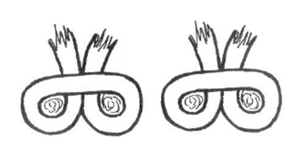
Symmetrical (Persian) knots on a single weft foundation. Boundary lines on the borders of rugs will usually have only one knot. These boundary lines on the back will show two nodes when the warp is not depressed. Many rug lovers want to know the knot count of their rugs. If you count nodes rather than knots you could be wrong by a factor of 2. There is a big difference in quality from 100 to 50 knots per sq. in. It is much easier to remove soil from this more open weave without an inner core to collect dirt.
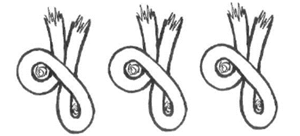
Side view of symmetrical (Turkish) knots with depressed warp. Boundary lines on the borders of rugs will usually have only one knot. These boundary lines on the back will only show one node when it is a depressed warp. Most rugs with Turkish knots will not have a depressed warp. For this type of construction, every node is a knot.
The depressed warp creates an open core for dirt to be trapped deeper into the rug. The depressed warp necessitates more time and techniques to dust the rug properly. The Persian Bidjar is known as the “iron rug”. These types of rugs are the hardest to dust properly.
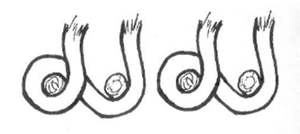
Asymmetrical (Persian) knot from a side view. Boundary lines on the borders of rugs will usually have only one knot. These boundary lines on the back will show two nodes when the warp is not depressed. Many rug lovers want to know the knot count of their rugs. If you count nodes rather than knots you could be wrong by a factor of 2. There is a big difference in quality from 200 to 100 knots per sq. in. It is much easier to remove soil from this more open weave.
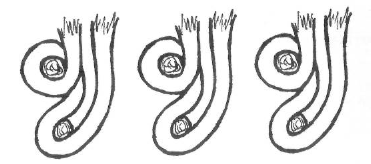
Side view of asymmetrical (Persian) knots with depressed warp. Boundary lines on the borders of rugs will usually have only one knot. These boundary lines on the back will only show one node when it is a depressed warp.
Most rugs with Persian knots will have a depressed warp. For this type of construction, every node is a knot. The depressed warp creates an open core for dirt to be trapped deeper into the rug. The depressed warp necessitates more time and techniques to dust the rug properly.
-By Tom Forsythe and Scott Warrington
